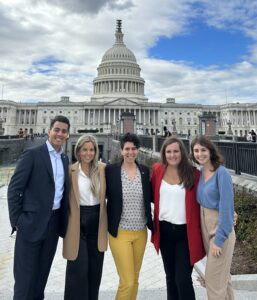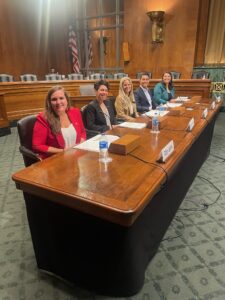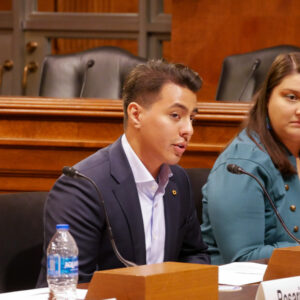As a child, I had been to Washington, D.C. many times, always seeing the Capitol building from afar and never up close. I remember staring at it in all its grandeur and imagining all the powerful decision-making taking place behind closed doors. I never imagined I would step foot inside the building several years later. That all changed the morning of October 16th when I was part of the CWS briefing to Congress calling for the protection of unaccompanied children.
An unaccompanied child is a foreign-born child under age 18 and without legal status in the United States, whom at the time of their identification by immigration officials, are not in the care and custody of their parents or legal guardian. Many experience violence and direct threats to their lives in their home country and they make the incredibly difficult decision to leave everything they’ve ever known behind to seek safety and reunite with their family. Once they arrive in the United States, organizations like CWS and our Home Study and Post Release Services Program work to promote the safety and well-being of unaccompanied children released from the Office of Refugee Resettlement custody and into the care of a sponsor. We help identify if the placement appears appropriate for reunification and connect the child and sponsor to appropriate community resources to meet their needs. Our visit to Congress was meant to further educate them on our program, bring in the voices of the children we walk alongside and additional services they need, and share clear ways Congress can invest and support those we welcome by advancing policies and additional funding.
When the day came for our visit to the Hill, time seemed to move incredibly slowly. This felt odd to me since it felt like I blinked and two weeks of preparation time vanished. I also thought I would be a nervous wreck leading up to it, but it was the opposite; I felt warm, excited and optimistic. I think a large part of that was due to the support from so many colleagues, many of whom I was meeting in person for the first time that day! As I walked from the CWS D.C. office to the Capitol building, I began doing some breathwork to be present in that moment. Breathing as I followed our leader in cool underground tunnels. Breathing as I passed through the metal detector. Breathing as I walked through the green marble halls I never thought I’d step foot in, taking it all in until I reached our room. The room was larger than I was expecting. The high ceilings, wood-framed walls and so many bright lights that everything about it felt majestic. A long wooden table with five chairs and microphone stands like the ones I see on TV sat in the center of the room with 20-25 black chairs forming half a circle on an elevated surface behind us and 100+ chairs for the audience in front of us. It all began to feel more and more real with every passing minute.
There were five of us on the panel, four of whom were from CWS’ Children’s Services Department and one colleague from the Policy and Advocacy team. Our briefing was scheduled for 60 minutes, 35 of which were for our panel speeches and 25 for a moderated Q&A. We each had seven minutes to give Congress an overview of who unaccompanied children are, the dangers they face while seeking safety, what happens when they arrive in the U.S. and CWS’ role in ensuring their well-being. Our goal was to share how Congress can support children and families and help them integrate and thrive in their new homes while holding the administration accountable for supporting policies that improve the care for these children.
As I listened to each of my colleagues read from their scripts, I found myself getting emotional when they got emotional, and I remember thinking that I hoped everyone was listening to our passion and experience and taking it all in. I felt calm and relaxed, viewing myself as a spectator even though I was on the panel myself. When I knew it was getting closer to my turn to speak, I felt my heart beat faster and my shoulders caving in, closing up my chest. As soon as my colleague said her last word, I sat up with my back off the chair, pushed my shoulders back, took a deep breath and pressed the green button to turn on my microphone and start the timer. Once I found a steady pace and tone, everything came naturally. I had rehearsed the key points I wanted to make many times the night before and, in that moment, I wanted to make eye contact with everyone in that room so they connected with what I was saying. I remember receiving many head nods and seeing a few necks stretch to find my voice. In the end, each of our sections added nicely to what was shared before, and I was proud of how clear and concise we were in advocating for robust funding for post-release services, legal representation, mental health services and child advocates.
Although many of the questions that were asked were program-specific (and my colleagues all did an incredible job at responding and educating with additional information), I felt honored and proud to share the stories of our clients and how they are resilient and thriving with support from our program and their communities. I felt it was important to show members of Congress how communities across the United States are welcoming unaccompanied children with empathy and compassion, so they too recognize the importance of investing in those we welcome and our communities’ support. I was also glad to learn afterward that we had bipartisan attendance and engagement during our briefing, and I hope everyone left that room with new information and even a 0.1% more positive perspective. But after all the success, do you want to know what the best part of the briefing was, in my opinion? Catching Meredith Owen, Director of Policy and Advocacy, have a silent celebration and mouthing “YES!” in the front row in response to a question she anticipated.
As we continue to walk alongside unaccompanied children and provide them with the support they need, you can help us by taking action and urging Congress to fund programs that ensure the safety and well-being of unaccompanied children. You can also find our policy asks, CWS factsheet on unaccompanied children and our Children’s Services one-pager at the link above. If you want to learn more about the work we’re doing across the United States in welcoming unaccompanied children and their families and how you can get involved, please email us at welcomingchildren@cwsglobal.org.
Sebastian is the Community Engagement Officer for Children’s Services. He would like to thank his CWS colleagues and friends who helped him prepare for the briefing and showed up for moral support and to Christine Lemonda, for opening the door to this opportunity.



